What would your future-you have to say to you?
The no-pants guide to spending, saving, and thriving in the real world.
What would your future-you have to say to you?
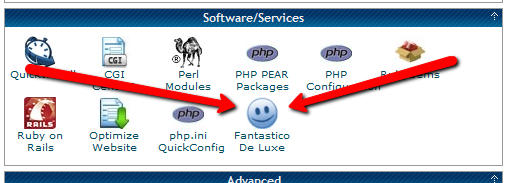
In this installment of the Make Extra Money series, I’m going to show you how to set up a WordPress site. I’m going to show you exactly what settings, plugins, and themes I use. I’m not going to get into writing posts today. That will be next time.
I use WordPress because it makes it easy to develop good-looking sites quickly. You don’t have to know html or any programming. I will be walking through the exact process using Hostgator, but most hosting plans use CPanel, so the instructions will be close. If not, just follow WordPress’s 5 minute installation guide.
Assuming you can follow along with me, log in to your hosting account and find the section of your control panel labeled “Software/Service”. Click “Fantastico De Luxe”.

On the Fantastico screen, click WordPress, then “New Installation”.
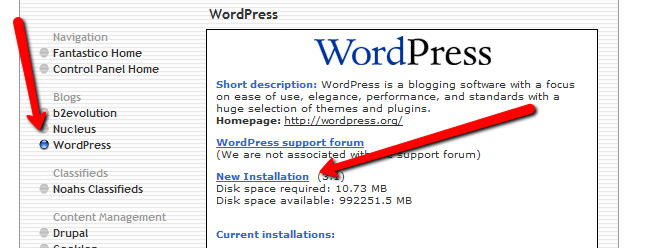
On the next screen, select your domain name, then enter all of the details: admin username, password, site name, and site description. If you’ll remember, I bought the domain http://www.masterweddingplanning.net. I chose the site name of “Master Wedding Planning” and a description of “Everything You Need to Know to Plan Your Wedding”.
Click “install”, then “finish installation”. The final screen will contain a link to the admin page, in this case, masterweddingplanning.net/wp-admin. Go there and log in.
After you log in, if there is a message at the top of the screen telling you to update, do so. Keeping your site updated is the best way to avoid getting hacked. Click “Please update now” then “Update automatically”. Don’t worry about backing up, yet. We haven’t done anything worth saving.
Next, click “Settings” on the left. Under General Settings, put the www in the WordPress and site URLs. Click save, then log back in.
Click Posts, then Categories. Under “Add New Category”, create one called “Misc” and click save.
Click Appearance. This brings you to the themes page. Click “Install Themes” and search for one you like. I normally use Headway, but before I bought that, I used SimpleX almost exclusively. Your goal is to have a simple theme that’s easy to maintain and easy to read. Bells and whistles are a distraction.
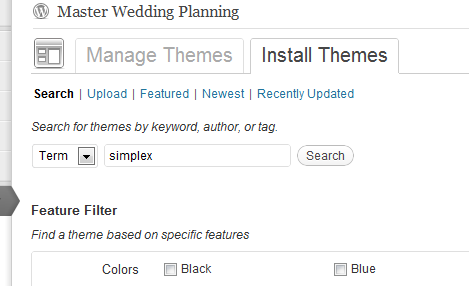
Click “Install”, “Install now”, and “Activate”. You now have a very basic WordPress site.
A plugin is an independent piece of software to make independent bits of WordPress magic happen. To install the perfect set of plugins, click Plugins on the left. Delete “Hello Dolly”, then click “Add new”.
In the search box, enter “plugin central” and click “Search plugins”. Plugin Central should be the first plugin in the list, so click “install”, then “ok”, then “activate plugin”. Congratulations, you’ve just installed your first plugin.
Now, on the left, you’ll see “Plugin Central” under Plugins. Click it. In the Easy Plugin Installation box, copy and paste the following:
All in One SEO Pack Contact Form 7 WordPress Database Backup SEO SearchTerms Tagging 2 WP Super Cache Conditional CAPTCHA for WordPress date exclusion seo WP Policies Pretty Link Lite google xml sitemaps Jetpack by WordPress.com
Click “install”.
On the left, click “Installed Plugins”. On the next screen, click the box next to “Plugins”, then select “Activate” from the dropdown and click apply.
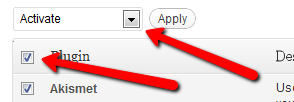
Still under Plugins, click “Akismet Configuration”. Enter your API key and hit “update options”. You probably don’t have one, so click “get your key”.
The only tool I worry about is the backup. It’s super-easy to set up. Click “Tools”, then “Backup”. 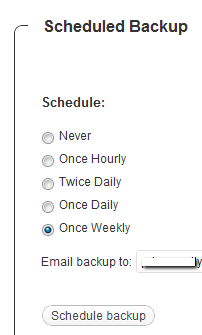
Scroll down to “Schedule Backups”, select weekly, make sure it’s set to a good email address and click “Schedule Backup”. I only save weekly because we won’t be adding daily content. Weekly is safe enough, without filling up your email inbox.
There are a lot of settings we’re going to set. This is going to make the site more usable and help the search engines find your site. We’re going to go right down the list. If you see a section that I don’t mention, it’s because the defaults are good enough.
Set the Default Post Category to “Misc”.
Visit this page and copy the entire list into “Update Service” box. This will make the site ping a few dozen services every time you publish a post. It’s a fast way to get each post indexed by Google.
Click “Save Changes”.
Uncheck everything under “Email me whenever…” and hit save. This lets people submit comments, without actually posting the comments or emailing me when they do so. Every once in a while, I go manually approve the comments, but I don’t make it a priority.
Select “Custom structure” and enter this: /%postname%/
Click save.
Set the status to “Enabled”, then fill out the site title and description. Keep the description to about 160 characters. This is what builds the blurb that shows up by the link when you site shows up in Google’s results.
Check the boxes for “Use categories for META keywords” and “Use noindex for tag archives”.
Click “Update Options”.
Check the boxes to remove each of the dates and set the alt text to “purpose” or something. This will suppress the date so your posts won’t look obsolete.
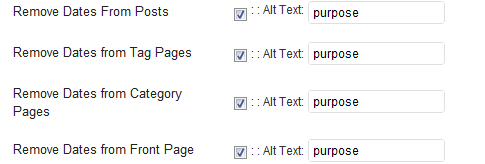
This plugin reinforces the searches that bring people to your site. It’s kind of neat. Skip the registration, accept the defaults and hit save.
Scroll to the bottom and click import. We’ll come back to this.
Select “Caching On” and hit save.
Across the top of the screen should be a giant banner telling you to connect to WordPress.com and set up Jetpack. You’ll need an account on WordPress.com, so go there and set one up. After authorizing the site, you’ll be brought back to the Jetpack configuration screen. Click “Configure” under “WordPress.com Stats”. Take the defaults and hit save.
On the contact configuration page, copy the code in the top section. You’ll need this in a moment.
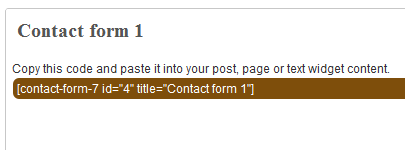
Now, we going to create a couple of static pages. On the left, click “Pages”, then “Add new”.
Name the first page “Contact” and put the contact form code in the body of the page. Hit publish.
Under Appearance, click “Menu”. Enter a menu name and hit save.
Then, under “Pages”, click the box next to “Contact”, “Disclaimer”, and any other policies you’d like to display. Hit save.
Also under Appearance, click “Widgets”. This is where you’ll select what will display in the sidebar. All you have to do is drag the boxes you want from the middle of the page to the widget bar on the right. I recommend Text, Search, Recent Posts, Popular Search Terms and Tag Cloud. In the text box, just put some placeholder text in it, like “Product will go here”. We’ll address this next time.
We’re not going to worry about getting posts in place, yet. That will be the next installment. However, the steps in the next installment could take 2 weeks to implement, and we want Google to start paying attention now. To make that happen, we need to get a little bit of content in place. This won’t be permanent content. It’s only there so Google has something to see when it comes crawling.
To get this temporary, yet legal content, I use eZineArticles. Just go search for something in your niche that doesn’t look too spammy.
Then, click “Posts”, then delete the “Hello World” post. Click “Add new”. Copy the eZine article, being sure to include the author box at the bottom, and hit publish.
To see your changes, you may have to go to Settings, then WP Cache and delete the cache so your site will refresh.
Congratulations! You now have a niche blog with content. It’s not ready to make you any money, yet, but it is ready for Google to start paying attention. In the next installment, I’ll show you how I get real unique content and set it up so Google keeps coming back to show me the love.

…err, no more car loan. I paid off my car this week, a year early! Now I’m down to 2 debts: a credit card with an embarrassingly high balance and my mortgage. We’re rocking the debt snowball!
INGDirect is having a sweet promotion. Open a checking account, use it three times in 45 days, and get $50 free. Free money is the best kind. I love my ING account and keep all of my savings there. If you don’t have an account there, yet, now is a great time to open one.
This month, I am trying to establish the Slow Carb Diet as a habit. At the end of the month, I’ll see what the results were and decide if it’s worth continuing. For those who don’t know, the Slow Carb Diet involves cutting out potatoes, rice, flour, sugar, and dairy in all their forms. My meals consist of 40% proteins, 30% vegetables, and 30% legumes(beans or lentils). There is no calorie counting, just some specific rules, accompanied by a timed supplement regimen and some timed exercises to manipulate my metabolism. The supplements are NOT effedrin-based diet pills, or, in fact, uppers of any kind. There is also a weekly cheat day, to cut the impulse to cheat and to avoid letting my body go into famine mode.
I’m measuring two metrics, my weight and the total inches of my waist , hips, biceps, and thighs. Between the two, I should have an accurate assessment of my progress.
Weight: I have lost 17 pounds since January 2nd. That’s 6 pounds since last week. I cheated this week and had a slice of toast and 6 croutons with my grilled chicken-but-no-cheese salad.
Total Inches: I have lost 9 inches in the same time frame, down 3.5 since last week.
Naturally, the first week is the most dramatic. That’s when my body was flushing most of the garbage I’d been eating, including holiday feasts. I’ll have a hard time complaining about 6 pounds in a week. My guess is that I drop another 10-15 pounds by the end of the month, bringing the average to about 1 pound per day. Over time, that will drop as my base caloric burn drops to match my new weight.
Realized Returns is giving away a Kindle. I would greatly appreciate it if you didn’t enter, because I’d love to get a Kindle.
Maximizing Money has put together a stellar list of financial blogs. If I’m not enough to keep you going, take a look at that list.
Mystery shopping sounds like it could be such a sweet deal for some people. Always try to make money doing what you love.
Here is another list of sites that can make you some money. I love side hustles.
And finally, here is Lifehacker, showing you how to make better cocoa.
This is where I review the posts I wrote one year ago.
I wrote a post on saving money while cooking. This post has easily withstood the test of time. We keep getting better at stretching our budget. Over the last year, we’ve actually reduced our food budget by an additional $50 per month, while the quality of our meals has gone up.
This was the first week I posted a 30 Day Project update. My first goal was to start waking up at 5AM. That worked well for almost the entire year, but I’ve let that slack off over the last few months. On the weekends, I don’t set an alarm or try to get up early, but I’m still up by 7:30, usually. During the week, my alarm goes off at 5:10, but I let myself snooze it. I’ve discovered that I do better at attending to my personal projects(like blogging) late at night instead of early in the morning. So, I’m going with what works, instead of trying to force what doesn’t.
I also reviewed the bills I pay that aren’t paid monthly in my third budget lesson.
First 3 Things to Do in the New Year was included in Crystal’s rockin’ new Total Money Carnival.
4 Ways We Keep Wasting Money was included in the Festival of Frugality.
Living the XBox Life on an Atari Income was included in the Carnival of Personal Finance.
Swamp Finance was hosted by Squirrelers.
I ran the guest post, The Best Financial Advice I Ever Received for Saving Money Today.
Thank you! If I missed anyone, please let me know.
There are so many ways you can read and interact with this site.
You can subscribe by RSS and get the posts in your favorite news reader. I prefer Google Reader.
You can subscribe by email and get, not only the posts delivered to your inbox, but occasional giveaways and tidbits not available elsewhere.
You can ‘Like’ LRN on Facebook. Facebook gets more use than Google. It can’t hurt to see what you want where you want.
You can follow LRN on Twitter. This comes with some nearly-instant interaction.
You can send me an email, telling me what you liked, what you didn’t like, or what you’d like to see more(or less) of. I promise to reply to any email that isn’t purely spam.
That’s all for today. Have a great weekend!
Today, I am continuing the series, Money Problems: 30 Days to Perfect Finances. The series will consist of 30 things you can do in one setting to perfect your finances. It’s not a system to magically make your debt disappear. Instead, it is a path to understanding where you are, where you want to be, and–most importantly–how to bridge the gap.
I’m not running the series in 30 consecutive days. That’s not my schedule. Also, I think that talking about the same thing for 30 days straight will bore both of us. Instead, it will run roughly once a week. To make sure you don’t miss a post, please take a moment to subscribe, either by email or rss.
On this, Day 6, we’re going to talk about cutting your expenses.
Once you free up some income, you’ll get a lot of leeway in how you’re able to spend your money, but also important–possibly more important–is to cut out the crap you just don’t need. Eliminate the expenses that aren’t providing any value in your life. What you need to do is take a look at every individual piece of your budget, every line item, every expense you have and see what you can cut. Some of it, you really don’t need. Do you need a paid subscription to AmishDatingConnect.com?
If you need to keep an expense, you can just try to lower it. For example, cable companies regularly have promotions for new customers that will lower the cost to $19 a month for high-speed internet. Now, if you call up the cable company and ask for the retention department, tell them you are going to switch to a dish. Ask, “What are you willing to do to keep my business?” There is an incredibly good chance that they will offer you the same deal–$20 a month–for the next three or four months. Poof, you save money. You can call every bill you’ve got to ask them how you can save money.
I called my electric company and my gas company to get on their budget plans. This doesn’t actually save me money but it does provide me with a consistent budget all year long, so instead of getting a $300 gas bill in the depths of January’s hellish cold, I pay $60 a month. It is averaged out over the course of the year. It feels like less and it lets me get a stable budget. Other bills are similar. You can call your credit card companies and tell them everything you take your business to another card that gave you an offer of 5% under what ever you are currently paying. It doesn’t even have to be a real offer. Just call them up and say you are going to transfer your balance away unless they can meet or beat the new interest rate. If you’ve been making on-time payments for any length of time–even six months or a year–they’re going to lower the interest rate business, no problem. Start out by asking for at least a 5% drop. In fact, demand no more than 9.9%.
Once you’ve gone through every single one of your bills, you’ll be surprised by how much money you’re no longer paying, whether it’s because somebody lowered the bill for you or you scratched it off the list completely.
Today, I am continuing the series, Money Problems: 30 Days to Perfect Finances. The series will consist of 30 things you can do in one setting to perfect your finances. It’s not a system to magically make your debt disappear. Instead, it is a path to understanding where you are, where you want to be, and–most importantly–how to bridge the gap.
I’m not running the series in 30 consecutive days. That’s not my schedule. Also, I think that talking about the same thing for 30 days straight will bore both of us. Instead, it will run roughly once a week. To make sure you don’t miss a post, please take a moment to subscribe, either by email or rss.
On this, Day 8, we’re going to talk about insurance.
What is insurance? Insurance is, quite simply a bet with your insurance company. You give them money on the assumption that something bad is going to happen to whatever you are insuring. After all, if you pay $10,000 for a life insurance policy and fail to die, the insurance company wins.
A more traditional definition would be something along the line of giving money to your insurance company so they will pay for any bad things that happen to your stuff. How do they make money paying to fix or replace anything that breaks, dies, or spontaneously combusts? Actuary tables. Huh? The insurance company sets a price for to insure—for example—your car. That price is based on the statistical likelihood of you mucking it up, based on your age, your gender, your driving history, and even the type of car you are insuring. What happens if a meteor falls on your car? That would shoot the actuary table to bits, but it doesn’t matter. They spread the risk across all of their customers and—statistically—the price is right.
What kinds of insurance should you get?
For most people, their home is, by far, the largest single purchase they will ever make. If your home is destroyed, by fire, tornado, or angry leprechauns, it’s gone, unless you have it insured. Without insurance, that $100, or 200, or 500 thousand dollars will be lost, and that’s not even counting the contents of your home.
Homeowner’s insurance can be expensive. One way to keep the cost down is to raise your deductible. If you’ve got a $1500 emergency fund, you can afford to have a $1000 deductible. That’s the part of your claim that the insurance company won’t cover. It also means that if you have less than $1000 worth of damage, the insurance company won’t pay anything.
You can get optional riders on your homeowner’s insurance, if you have special circumstances. You can get additional coverage for jewelry, firearms, computer equipment, furs, among other things. You base policy will cover some of this, but if you have a lot of any of that, you should look into the extra coverage.
Car insurance is required in most states. That’s because the kind caretakers in our governments, don’t want anyone able to hit you car without being able to pay for the damage they caused. To my mind, I think it would be more effective to just make whacking someone’s car without paying for it a felony. If someone is a careful driver or has the money to self-insure, more power to them.
Auto insurance comes with options like separate glass coverage, collision, total coverage (comprehensive), or just liability. Liability insurance is what you put on cheap, crappy cars. It will only pay for the damage you do to someone else.
I’ve never had rental insurance. The last time I rented, I could fit everything I owned in the back of a pickup truck with a small trailer, and it could all be replaced for $100. Heck, I had the couch I was conceived on. Err. Ignore that bit.
Almost everything you can get homeowner’s insurance to cover will also cover renter’s insurance, except for the building. It’s not your building, so it’s not your job to replace it.
If you care about your family, you need life insurance. This is the money that will be used to replace your income if you die. I am insured to about 5 times my annual salary. If that money gets used to pay off the last of the debt, it will be enough to supplement my wife’s income and support my family almost until the kids are in college. You should be sure to have enough to cover any family debt, and bridge the gap between your surviving family’s income and their expenses. At a minimum. Better, you’ll have enough to pay for college and a comfortable living.
Life insurance comes in two varieties: whole and term. Whole life…sucks. It’s expensive and overrated. The sales-weasels pushing it will tell you that it builds value over time, but it’s usually only about 2%. It’s a lousy investment. You’re far better off to get a term life policy and sock the price difference in a mutual fund that’s earning a 5-6% return.
Term life is insurance that is only good for 5, 10, or 20 years, then the policy evaporates. If you live, the money was wasted at the end of the term. The fact that it’s a bad bet makes it far more affordable than whole life. It doesn’t pretend to be an investment; it’s just insurance. Pure and simple
An umbrella policy is lawsuit insurance. If someone trips and hurts themselves in your yard, and decides to sue, this will pay your legal bills. If you get sued for almost anything that was not deliberate(by you!) or business related, this policy can be used to cover the bill.
If you call your insurance company to get an umbrella policy, they will force you to raise the limits on your homeowner’s and auto insurance. Generally, those limits will be raised to $500,000, and the umbrella coverage will be there to pick up any costs beyond the new limit.
A little-known secret about umbrella policies: They set the practical limit of a lawsuit against you. Most ambulance chasers know better than to sue you for 10 million dollars if you only have a policy to cover 1 million. They will never see the other 9 million, so why bother? They’ll go for what they know they can get.
The flipside to that is that you should not talk about your umbrella policy. Having a million dollars in insurance is a sign of “deep pockets”. It’s a sign that it’s worthwhile to sue you. You don’t want to look extra sue-able, so keep it quiet.
Insurance is a great way to protect yourself if something bad happens. Today, you should take a look at your policies and see where you may have gaps in coverage, or where you may be paying too much.
Today, I am continuing the series, Money Problems: 30 Days to Perfect Finances. The series will consist of 30 things you can do in one setting to perfect your finances. It’s not a system to magically make your debt disappear. Instead, it is a path to understanding where you are, where you want to be, and–most importantly–how to bridge the gap.
I’m not running the series in 30 consecutive days. That’s not my schedule. Also, I think that talking about the same thing for 30 days straight will bore both of us. Instead, it will run roughly once a week. To make sure you don’t miss a post, please take a moment to subscribe, either by email or rss.
On this, Day 9, we’re going to talk about health insurance.
The first thing to understand is that there is a difference between health care and health insurance. Health care is what the doctors do. Health insurance is when the insurance companies pay for it. Or don’t. They are not the same thing. I won’t be addressing who should get care or who should be paying for insurance. That’s political and I try to avoid that here.
I won’t spend much time discussing health care as a “right”. It’s not. If a right requires somebody to actively do something for you, it’s not a right. It can’t be. The logical conclusion of requiring somebody to provide you care gets to be a intellectual exercise to be completed elsewhere. That, too, is political.
What I will discuss are the components of a health insurance plan is the U.S. and what to watch out for when planning your insurance coverage.
This is the amount you pay for your health insurance. For people with employer-sponsored insurance, this is usually paid out of each paycheck, deducted pre-tax. For those with an individual plan, it’s almost always a monthly payment. There generally isn’t much you can do to lower this much. Most employers offer, at most, 2-3 options, ranging from a good plan for a high premium to “we’ll mail you leeches if we think you’re dying” for a much smaller price.
This is a flat fee paid out of pocket when you get medical care. Depending on your plan and the type of visit, this could be $10-50 or higher. For example, with a plan I participated in recently, the copay was $15 for an office visit, $25 for urgent care, and $100 for an emergency room visit. The office visit and urgent care visit were billed the same amount to the insurance company, so the price difference was entirely arbitrary. Currently, all health insurance plans are required to pay preventative care visits at 100%, meaning there is no copay.
This is the payment split between the insurance company and the insured. 80/20 is a common split for plans with coinsurance. That means the insurance company will pay just 80% of the bill, until the insured has paid the entire out-of-pocket maximum. After that, the coverage is 100%.
This is the amount that an insurance company won’t pay. It has to be covered by the insured before the insurance company does anything. For example, if you have an insurance plan with a $25 copay, 80/20 coinsurance and a $100 deductible, and paying for an office visit costing $600 would look something like this: $25 for the copay, followed by $75 to max out the copay, leaving $500 to be split 80/20 or $400 paid by the insurance company and $100 paid by the insured. That office visit would cost $200 out-of-pocket. The next identical visit would be cheaper because the deductible is annual and doesn’t get paid per incident. That one would cost $115 out of pocket.
Health Savings Account. For people with a high-deductible plan–that is, a plan with a deductible of at least $1200 in 2011–they are eligible to open an HSA. This is a savings account dedicated to paying medical expenses, excluding OTC medication. It can be used for vision, dental, or medical care. Payroll contributions are taken pre-tax, which makes it a more affordable way to afford major medical expenses. Unfortunately, there are annual contribution limits. Currently $3050 for an individual account and $6150 for a family account. HSAs do not expire, so you can contribute now, and save the money for medical expenses after retirement.
Flexible Spending Account. This is similar to an HSA, but the contributed funds evaporate at the end of the year. It’s “use it or you’re screwed” plan.
If you’re not getting health insurance through your employer or another group, you are on an individual plan. These cost more because they A) don’t benefit from the economy of scale presented by getting 50 or 100 or 1000 people on the same plan, and B) you don’t have an employer subsidizing your premium.
If your employer provides health insurance, you have an employer-sponsored plan. Possibly the fastest way to correct problems with the health insurance industry would be to make individual plan premiums tax-deductible, while eliminating that deduction for employers and letting insurance companies work across state lines. That would eliminate the mutated pseudo-market we have right now, and force the insurance companies to compete for your business. Honest competition is the most sure way to increase efficiency and service while reducing costs. It beats “one payer” or “socialized” care which add overhead to the process and hide the premiums in increased taxes.
Most employer-sponsored plans only allow you to make changes at a specific time of the year, unless you have a “life changing event”, like marriage, divorce, death, or children.
After you use your health insurance, the company will send an EOB, showing you what was billed, what they paid, and what you’ll be responsible for. It’s fascinating to see the difference between what gets billed by the doctor and what the insurance company is willing to pay, by contract. You should read this, to at least understand what you are consuming and how much is getting paid for you.
If your insured care cost more than your maximum dollar limit, or maximum annual limit, the insurance company stops paying. this was supposed to be going away under the Patient Protection and Affordable Care Fraud Act. Unfortunately, if an insurance company offers a crap plan, they have been allowed to apply for waivers based on the fact that they offer a crap plan. The deciding factor in whether the waiver is granted seems to be the amount of the political contributions the insurance company has made to the correct political entities, but maybe I’m just bitter.
This is the most you will have to pay directly with coinsurance. After you pay this amount, the insurance company will cover 100% of expenses, subject to the maximum limit.
The Consolidated Omnibus Budget Reconciliation Act of 1985 is, in short, an opportunity to continue your employer-sponsored health plan–minus the subsidy–after you have left the employer. It’s expensive, but it keeps you covered, and will eliminate issue with pre-existing conditions when you get a new plan.
This is an extremely-high-deductible plan, typically $10,000 or more. For the people who can’t afford coverage, this is insurance-treated-as-insurance. It’s coverage when you absolutely need it, not when you feel a bit ill. $10,000 isn’t a bankruptcy-level bill, while $100,000 usually is. This plan prevent medical bankruptcy for a small monthly fee. For the people who got screwed by a PPAACFA waiver, it bridges the gap between a plan that’s useful for minor things and protection when something goes really wrong.
Now that we’ve looked at the terms you need to understand, we’re going to talk about some things to check before deciding what coverage is right for you.
Do you need coverage for yourself, or yourself and your family? If you and your spouse are both working, make sure to run the math for every possible combination that will cover everyone. Is it cheaper to have one of you cover yourself and the kids, while the other just gets an individual plan?
It’s really easy to blow through a $3000 annual maximum. If you’ve got a low annual max, look into a supplemental catastrophic plan.
For years, my wife paid for insurance that covered herself and the kids, while I covered myself. When we were expecting brat #3, I added her to my insurance plan, without having her cancel hers. When the bill came, my insurance plan covered the coinsurance and deductible, which saved us thousands of dollars when the baby was born.
If you’ve got a pre-existing condition, it can be difficult to get insurance if you don’t already have coverage. This makes sense. It prevents someone from corrupting the idea of insurance by waiting until something goes really wrong before getting a plan. Without this, all of the insurance companies would be bankrupt in a year. This is one of the biggest benefits of COBRA. It’s a short-term bridge plan that eliminates the idea of a pre-exisiting condition deadbeat. If you’ve got insurance, you can transfer to a different plan. If you don’t, you can’t.
Your homework today is to get a copy of the details of your health insurance and look up all of the above terms and situations. How well are you covered? Did anything surprise you?